

Click here for a key to the symbols used. An explanation of acronyms may be found at the bottom of the page.
 Routing
Routing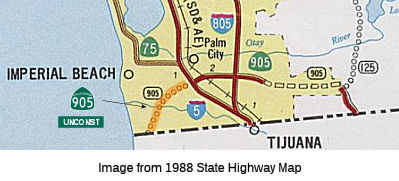 The international boundary near Border Field northeasterly to Route 5.
The international boundary near Border Field northeasterly to Route 5.
 Post 1964 Signage History
Post 1964 Signage HistoryIn 1986, Chapter 928 defined this segment as part of Route 905.
 Status
Status This part of the routing is unconstructed. This is an environmentally sensitive area, and there are no plans to develop this
segment.
This part of the routing is unconstructed. This is an environmentally sensitive area, and there are no plans to develop this
segment.
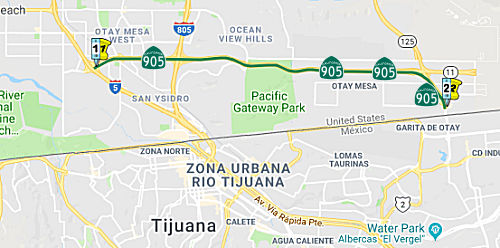 Route 5 near the south end of San Diego Bay to the International Boundary
southerly of Brown Field.
Route 5 near the south end of San Diego Bay to the International Boundary
southerly of Brown Field.
 Post 1964 Signage History
Post 1964 Signage HistoryIn 1986, Chapter 928 defined this segment as part of Route 905. It was a transfer from Route 117, was added. In 1986, the original Route 117 routing was lengthened when the portion from Route 125 to the International Boundary was transferred from Route 125.Caltrans assumed maintenance of this segment from the border to Route 125 on 7/1/1990.
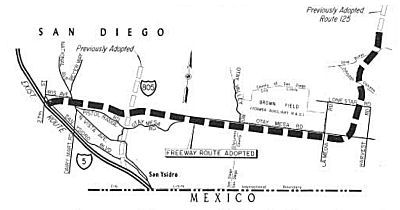 This section of Route 905 was brought into the Freeway
& Expressway System in 1959, and it is part of the National Highway
System (NHS). The route begins at the Point of Entry (POE), United
States/Mexico Otay Mesa border crossing, and proceeds north to northwest
to I-5. It has major interchanges with Route 125, I-5, and I-805. On June
29, 1965, the California Highway Commission adopted Route 75 segment (a),
later renumbered as Route 117, and now Route 905, as a freeway from I-5 to
Route 125. On January 2, 1969, a Freeway Agreement with the County of San
Diego was executed for Route 905 between Heritage Road and Route 125 at
Otay Mesa Road. The route is part of the Interregional Road System, from
1.6 kilometers (1.0 miles) east of Heritage Road to the POE. The portion
of Route 905 from I-5 to I-805 is designated as part of the national
network for the Surface Transportation Assistance Act. The portion of
Route 905 from I-5 to 2.1 kilometers (1.3 miles) east of I-805 is
constructed. The remaining portion of Route 905 to Route 125 is currently
unconstructed. Route 905 is the primary east-west interregional route
between the Otay Mesa border area of San Diego County and the cities of
Chula Vista, Imperial Beach, and the San Diego metropolitan region.
This section of Route 905 was brought into the Freeway
& Expressway System in 1959, and it is part of the National Highway
System (NHS). The route begins at the Point of Entry (POE), United
States/Mexico Otay Mesa border crossing, and proceeds north to northwest
to I-5. It has major interchanges with Route 125, I-5, and I-805. On June
29, 1965, the California Highway Commission adopted Route 75 segment (a),
later renumbered as Route 117, and now Route 905, as a freeway from I-5 to
Route 125. On January 2, 1969, a Freeway Agreement with the County of San
Diego was executed for Route 905 between Heritage Road and Route 125 at
Otay Mesa Road. The route is part of the Interregional Road System, from
1.6 kilometers (1.0 miles) east of Heritage Road to the POE. The portion
of Route 905 from I-5 to I-805 is designated as part of the national
network for the Surface Transportation Assistance Act. The portion of
Route 905 from I-5 to 2.1 kilometers (1.3 miles) east of I-805 is
constructed. The remaining portion of Route 905 to Route 125 is currently
unconstructed. Route 905 is the primary east-west interregional route
between the Otay Mesa border area of San Diego County and the cities of
Chula Vista, Imperial Beach, and the San Diego metropolitan region.
On March 24, 1983, the Commission adopted Route 905 (Route 125) from the Port of Entry to Otay Mesa road 0.8 kilometers (0.5 miles) west of Harvest Road. The members of the CTC expressed support for the extension project, the construction of Route 905 from 0.1 kilometers (0.06 miles) east of I-805 to the Port of Entry, during a tour of Route 905 and the Otay Mesa Border on September 19, 1997. On October 3, 2001, the Commission adopted a portion of Otay Mesa Road as a traversable highway from 2.1 kilometers (1.3 miles) east of I-805 to 2.1 kilometers (1.3 miles) west of the Port of Entry. This adoption provided for a state highway between I-805 and the Port of Entry. Traffic currently uses Otay Mesa Road as a traversable highway. The Department approved the Project Report for the Route 905 extension project on July 30, 2004. On October 28, 2004, the Commission adopted a portion of Route 905 from the junction with Route 125 to the Port of Entry.
 Pre 1964 Signage History
Pre 1964 Signage HistoryThis routing was approximately LRN 281, defined in 1959, although its proposed routing was slighly N of the current Route 905.
 Status
StatusThe original road, Otay Mesa Road, was a four to six lane road. It has heavy truck traffic and no center divider. It is maintained by the City of San Diego. There are "End CA-905" signs where the freeway ends just east of I-805. Where the road turns south toward Mexico, there are "BEGIN CA-905" signs. Some portions of this, near RM 12.0, were up for relinquishment in February 2001.
Route 905 Freeway
![[TCRP 86]](maps/905-tcrp-86.jpg) Part (2) of the routing was unconstructed from 1 mi E of Route 805 to Route 125 in 2001. This is currently under
construction, but funding was an issue. However, in June 2001, $25 million
towards the project was received from the State Transportation Commission,
moving the project closer to its funding goal. This is TCRP Project #86.
The state needs an estimated $264 million to build a new seven-mile
freeway. Right-of-way acquisition occurred under the Department’s
Policy for Early Acquisition. The Final Environmental Impact Statement was
approved in July 2004. The size and complexity of the project and numerous
design changes required several environmental studies to be redone. In
addition, review of the draft and final document by external stakeholders
took longer than anticipated. Although right-of-way acquisition proceeded
under “Early Acquisition,” the lack of an approved
environmental document prevented the purchasing of all the right-of-way
necessary for the project. According to Don Hagstrom in October 2002,
Route 905 began construction, with an interchange planned at Siempre Viva,
the last intersection / stoplight that one reaches when traveling south on
Route 905 into Tijuana. The rest of the freeway, from Siempre Viva to just
east of I-805 (where the current freeway begins) will go under
construction in 2004, with completion set for 2007 or so. Some of the
signs announcing the freeway mistakenly have an interstate shield. In
April 2006, the CTC considered a request to update the project schedule
and funding plan. The updated schedule shows: Phase 1: FY 2004/2005; Phase
2: FY 2006/2007; Phase 3: FY 2007/2008; Phase 4: FY 2010/2011.
Part (2) of the routing was unconstructed from 1 mi E of Route 805 to Route 125 in 2001. This is currently under
construction, but funding was an issue. However, in June 2001, $25 million
towards the project was received from the State Transportation Commission,
moving the project closer to its funding goal. This is TCRP Project #86.
The state needs an estimated $264 million to build a new seven-mile
freeway. Right-of-way acquisition occurred under the Department’s
Policy for Early Acquisition. The Final Environmental Impact Statement was
approved in July 2004. The size and complexity of the project and numerous
design changes required several environmental studies to be redone. In
addition, review of the draft and final document by external stakeholders
took longer than anticipated. Although right-of-way acquisition proceeded
under “Early Acquisition,” the lack of an approved
environmental document prevented the purchasing of all the right-of-way
necessary for the project. According to Don Hagstrom in October 2002,
Route 905 began construction, with an interchange planned at Siempre Viva,
the last intersection / stoplight that one reaches when traveling south on
Route 905 into Tijuana. The rest of the freeway, from Siempre Viva to just
east of I-805 (where the current freeway begins) will go under
construction in 2004, with completion set for 2007 or so. Some of the
signs announcing the freeway mistakenly have an interstate shield. In
April 2006, the CTC considered a request to update the project schedule
and funding plan. The updated schedule shows: Phase 1: FY 2004/2005; Phase
2: FY 2006/2007; Phase 3: FY 2007/2008; Phase 4: FY 2010/2011.
In October 2004, the CTC considered adoption of 1.9
kilometers (1.0 miles) of Freeway for Route 905 in the City of San Diego,
San Diego County, from 0.9 kilometers (0.6 miles) east of La Media Road to
the Otay Mesa Federal Port of Entry to Mexico. This would serve to extend
Route 905 from 0.1 kilometer east of I-805 to the Otay Mesa Federal Port
of Entry to reduce congestion, enhance the safe transportation of people,
goods, and services, and to improve the mobility of local, regional,
interregional, and international traffic. The project is coded
‘HE-14 New Facilities’ and has current funding from a large
number of sources including State, Interregional and Regional
Transportation Improvement Programs, the Transportation Equity Act for the
21st Century for the years 2000 to 2004, local funds and Transportation
Congestion Relief Program. Construction is scheduled for FY 2006-07. (![]() ref).
ref).
The SAFETEA-LU act, enacted in August 2005 as the reauthorization of TEA-21, provided the following expenditures on or near this route:
In his 2006 Strategic Growth Plan, Governor Schwartzenegger proposed completing Corridor Improvements and constructing a new 6-lane freeway route.
In March 2006, the CTC considered four public road connections at Heritage Road, Britannia Boulevard, Siempre Viva Road, and Enrico Fermi Drive. Enrico Fermi Drive connects within the Route 905/Route 125 Interchange. The Heritage Road Interchange is based on the opening of the circulation element roads of the City of San Diego General Plan. A diamond-type interchange is proposed at Britannia Boulevard, and a similar interchange is proposed for Siempre Viva Road. A full freeway-to-freeway interchange is proposed to connect Route 905 with Route 125 with a connector to Enrico Fermi Drive. The extension of this route will provide congestion relief for Otay Mesa Road, the only major east-west road currently servicing Otay Mesa and would allow direct access to I-5, I-805, and the Port of Entry. Route 905 would also provide future access to Route 11.
![[Rte 905 Completion]](maps/905-safetealu.jpg) In November and December 2006, Caltrans and San Diego Associated Governments (SANDAG) proposed to the CTC
the following State Transportation Improvement Program (STIP) Amendment
for the Route 905 freeway — Otay Mesa project in San Diego County:
(1) Program $81,289,000 of SAFETEA-LU Border Infrastructure Program (BIP)
funds to Construction in FY 2006-07. (2) Revise the project scope from a
four-lane freeway to a six-lane freeway as originally programmed. (3)
Shift $9,461,000 programmed in the Interregional Improvement Program (IIP)
from Construction to Environmental (PA&ED) and Design (PS&E). (4)
Shift $6,355,000 programmed in the IIP from Construction to Construction
Support. (5) Shift $1,209,000 programmed in the Regional Improvement
Program (RIP) from Construction to Construction Support. This project was
originally programmed to provide six travel lanes connecting Route 805 to
the Otay Mesa Border POE. The overall project is to be constructed in four
phases. Due to escalating construction costs that caused a substantial
funding shortfall to the project and to stay within STIP Programming
Guidelines, SANDAG and the Department down-scoped Phase 1 of the project
to a four-lane freeway from Siempre Viva to Britannia Boulevard in May
2005. In June 2006, a 12-month time extension for the period of project
allocation was approved for Construction programmed in FY 2005-06. This
allowed time for legislation to establish procedures for programming and
accessing SAFETEA-LU BIP funding to fully fund the original six-lane
freeway project. The Route 905 project is currently ready for
construction, but has an unfunded need of $93,289,000. The proposed
programming of $81,289,000 in SAFETEA-LU BIP funds and the availability of
$12,000,000 in SAFETEA-LU Earmarks, would fully fund Phase 1 of the
original six-lane freeway project. Phase 1 also includes interchanges at
Caliente Avenue, Britannia Boulevard, and La Media Road.
In November and December 2006, Caltrans and San Diego Associated Governments (SANDAG) proposed to the CTC
the following State Transportation Improvement Program (STIP) Amendment
for the Route 905 freeway — Otay Mesa project in San Diego County:
(1) Program $81,289,000 of SAFETEA-LU Border Infrastructure Program (BIP)
funds to Construction in FY 2006-07. (2) Revise the project scope from a
four-lane freeway to a six-lane freeway as originally programmed. (3)
Shift $9,461,000 programmed in the Interregional Improvement Program (IIP)
from Construction to Environmental (PA&ED) and Design (PS&E). (4)
Shift $6,355,000 programmed in the IIP from Construction to Construction
Support. (5) Shift $1,209,000 programmed in the Regional Improvement
Program (RIP) from Construction to Construction Support. This project was
originally programmed to provide six travel lanes connecting Route 805 to
the Otay Mesa Border POE. The overall project is to be constructed in four
phases. Due to escalating construction costs that caused a substantial
funding shortfall to the project and to stay within STIP Programming
Guidelines, SANDAG and the Department down-scoped Phase 1 of the project
to a four-lane freeway from Siempre Viva to Britannia Boulevard in May
2005. In June 2006, a 12-month time extension for the period of project
allocation was approved for Construction programmed in FY 2005-06. This
allowed time for legislation to establish procedures for programming and
accessing SAFETEA-LU BIP funding to fully fund the original six-lane
freeway project. The Route 905 project is currently ready for
construction, but has an unfunded need of $93,289,000. The proposed
programming of $81,289,000 in SAFETEA-LU BIP funds and the availability of
$12,000,000 in SAFETEA-LU Earmarks, would fully fund Phase 1 of the
original six-lane freeway project. Phase 1 also includes interchanges at
Caliente Avenue, Britannia Boulevard, and La Media Road.
In April 2007, the CTC considered a STIP amendment that would (a) Program $80,000,000 of BIP funds to Right of Way in FY 2006-07, and (b) Revise the project scope from a four- lane freeway to a six- lane freeway from Britannia to Siempre Viva (Phase 1A- Eastern Segment of Phase 1).
In late 2007, Caltrans started the bidding process for the construction of the freeway from 0.6 Km East of Cactus Road to 0.3 Km West of the Mexico border.
In February 2009, the CTC was noticed that Caltrans and the San Diego Association of Governments (SANDAG) recommended that the following projects programmed in the Trade Corridors Improvement Fund (TCIF) and the 2008 State Transportation Improvement Program (STIP) be reprogrammed as a corridor (i.e., with Federal funds), with funding levels to be based on the state funds previously allocated by the California Transportation Commission (Commission) and available local and federal funds:
The approved would allow the project to continue by using local or federal funds to meet the immediate cash flow needs of the projects that would otherwise be met with bond funds and the STIP amendment is necessary for this to occur.
In April 2009, the CTC approved funding this project [Route 905 in San Diego County project (PPNO 0703): Construct 6 Lane Freeway Phase 1B] (as a loan against future bonds) from 2009 Stimulus funds.
In February 2012, it was reported that the project to widen a connector ramp from westbound Route 905 to northbound I-805 was completed two months early and for $2 million less than expected. The $20 million project included the widening of an auxiliary lane along I-805 from Route 905 to Palm Avenue, and of the Del Sol Boulevard underpass.
In December 2012, it was reported that the freeway had been completed from I-5 to the International Border.
In October 2015, the CTC authorized relinquishment of right of way in the city of San Diego (11-SD-905U-PM-8.7/10.7 [Otay Mesa Road, Brittania to Harvest], 11-SD-905-R6.4/R10.7 [Otay Mesa Road/Airway to the 11/125/905 interchange]), consisting of a superseded highway and collateral facilities. The City, by cooperative agreement dated December 10, 1996 agreed to accept ownership, operation and maintenance of the superseded highway upon completion of the new Route 905 alignment, and by freeway agreement dated October 10, 2005, agreed to accept title to the collateral facilities of the new alignment upon relinquishment by the State. The 90-day notice period expired November 2, 2015, without exception.
In December 2013, the CTC authorized relinquishment of right of way in the city of San Diego along Route 905 between Britannia Boulevard (approx SD R8.801) and Airway Road (approx SD R10.949), consisting of a collateral facilities, as well as right of way in the city of San Diego along Route 905 between Cactus Road (approx SD R8.289) and Britannia Boulevard (approx SD R8.801), consisting of a collateral facilities.
In June 2017, the CTC authorized relinquishment of right of way in the county of San Diego along Route 905 on Otay Mesa Road (11-SD-905-PM R10.3/R10.9), consisting of superseded highway and collateral facilities. The County, by letter dated March 9, 2017, agreed to waive the 90-day notice requirement and accept title upon relinquishment by the State.
Route 905 (approx SD R10.545)/Route 11/Route 125 Connectors
In December 2012, the CTC updated the description of
the Route 905/Route 11 connectors project to be: "In San Diego County near
San Diego on Route 905 from 0.1 mile west of Britannia Boulevard
overcrossing to 1.6 miles east of La Media Road undercrossing. Route 11 from Route 11/905 Separation to Enrico Fermi Drive and on Route 905
from 0.1 mile East of La Media Road Undercrossing to 0.2 mile West of
Airway Road Undercrossing.
In May 2013, the CTC amended the TCIF Baseline Agreement for Segment 1 of Project 68 – Route 11/Route 905 Freeway to Freeway Connectors project (PPNO 0999A) in San Diego County to update the project funding plan. The CTC also approved $79,700,000 to fund construction.
In March 2014, the CTC authorized $800,000 for the Route 905/Route 125 Northbound Connectors.
In June 2014, the CTC amended the project plan to adjust funding, and to adjust the start of the construction phase to August 2014. This relates to the portion of the project that will construct the northbound connectors from Route 905 and future Route 11 to Route 125 near the Otay Mesa Port of Entry.
In January 2015, the CTC authorized $22,657,000 in additional funding for construction of the Route 905/Route 125 Northbound Connectors.
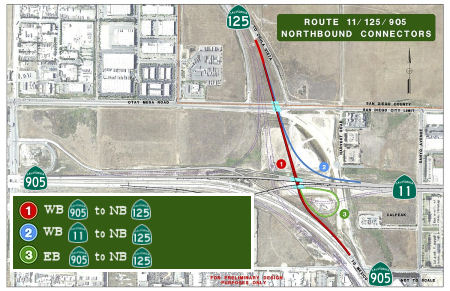 In October 2015, it was reported that work had begun on construction of the connectors
between Route 125, Route 905, and Route 11. Officials said over the past
two decades, trade between the U.S. and Mexico has grown by an average of
10 percent a year — an increase that exceeds that of U.S. trade with
the rest of the world. Last year, more than 800,000 northbound trucks and
$39 billion in goods passed through the Otay Mesa Port of Entry. The $21.5
million project is expected to be completed in late 2016. Funding sources
include a $15.9 million chunk from Proposition 1B Trade Corridors
Improvement Fund and $2.7 million from the TransNet half-cent sales tax
for transportation uses approved by San Diego County voters, among other
funding sources. Caltrans officials said the project is designed to remedy
one of the last missing links in the overall border road network.
Currently, truckers congest city streets and local roads to access Route 125. The new connectors will create a seamless highway system, greatly
reducing wait times at the border, according to Caltrans.
In October 2015, it was reported that work had begun on construction of the connectors
between Route 125, Route 905, and Route 11. Officials said over the past
two decades, trade between the U.S. and Mexico has grown by an average of
10 percent a year — an increase that exceeds that of U.S. trade with
the rest of the world. Last year, more than 800,000 northbound trucks and
$39 billion in goods passed through the Otay Mesa Port of Entry. The $21.5
million project is expected to be completed in late 2016. Funding sources
include a $15.9 million chunk from Proposition 1B Trade Corridors
Improvement Fund and $2.7 million from the TransNet half-cent sales tax
for transportation uses approved by San Diego County voters, among other
funding sources. Caltrans officials said the project is designed to remedy
one of the last missing links in the overall border road network.
Currently, truckers congest city streets and local roads to access Route 125. The new connectors will create a seamless highway system, greatly
reducing wait times at the border, according to Caltrans.
(Source: KPBS, 10/26/2015)
In November 2016, it was reported that construction
crews just wrapped up a year-long project that will help reduce congestion
at the Otay Mesa Port of Entry. Three freeway connectors that link Route 905 and Route 11 to the northbound South Bay Expressway (Route 125) opened
to traffic. More than 7,000 trucks travel across the Otay Mesa Border
Crossing every day. The heavy traffic here during rush hour has caused
major headaches for anyone trying to get to toll road Route 125 from Route 905 and Route 11. Before the connectors, vehicles exiting the Otay Mesa
Port of Entry had no direct access to northbound 125 and drivers were
forced to use local streets just to get there. Now, the new access will
provide another option of travel for people living in southern San Diego
and eastern Chula Vista. Drivers can avoid congestion on I-805 and I-5 by
going east on Route 905 and north on Route 125. Now that the northbound
connectors are complete, officials with SANDAG say they are hard at work
finishing up designs on the southbound connectors. That project expected
to begin construction in 2018.
(Source: CW 6, 11/30/2016)
With respect to the Southbound Connectors: In June
2019, it was reported that Skanska has won the construction contract for
Route 905 in San Diego, California. The $101 Million contract with
California Department of Transportation (Caltrans) is for a four-lane
highway with freeway connectors on Route 905, located at Otay Mesa, one of
three ports of entry in the San Diego-Tijuana Mexico metropolitan region.
Construction work includes two freeway-to-freeway flyover bridges that
will connect three highways (Route 125, Route 11 and Route 905), as well
as a 1.25-mile greenfield extension of Route 11 to the east toward a
future port-of-entry. The project will involve more than 15,000m3
of structural concrete, 30,000m3 of concrete paving, 35,000
tons of asphalt, and about 840,000 m3 of earthworks.
Construction is scheduled for completion in September 2021.
(Source: Construction Index, 6/10/2019)
In June 2019, the CTC amended the TCEP Project Baseline
Agreement and established it as the basis for project delivery and
monitoring. The amendment programmed $1,708,000 in savings from the TCIF
program for construction on the Route 125/Route 905 Connector project
(PPNO 1036) in San Diego County. This project is one of six projects
included in the Baseline Agreement for the California-Mexico Border System
Network Improvements. The Route 125/Route 905 Connector project will
construct a freeway to freeway South-West connector, thereby completing
the remaining connector needed to integrate three major state roads
serving the border region just north of the Otay Mesa Port of Entry at the
United States/Mexico border. In May 2018, the project received $21,980,000
in TCEP funding. In August 2018, the California-Mexico Border System
Network Improvements Baseline Agreement was approved, including this Route 125/905 Connector project. In February 2019, bid results from an adjacent
project along the same corridor reflected a 10 percent increase in project
costs. Upon review of those bid results, the project development team
prepared a revised cost estimate for the Route 125/905 Connector project
using the updated unit prices from the adjacent project. The revised
estimate indicated a cost increase of approximately $1,708,000. Therefore,
the Department and SANDAG propose to program $1,708,000 in TCIF savings
from other projects to this connector project. A construction allocation
of the programmed TCEP and TCIF funds is expected to be requested in Fall
2019.
(Source: June 2019 CTC Minutes, Agenda Item
2.1s.(1))
In June 2019, the CTC approved deallocating $770,000
from TCIF Project 68.1 – Route 11/Route 905 Freeway to Freeway
Connector Project in San Diego County, due to cost savings at the
completion of the project. (PPNO 11-0999A)
(Source: June 2019 CTC Minutes, Agenda Item
2.5g.(5b))
In June 2019, the CTC amended the Trade Corridors
Improvement Fund Program to add the Route 125/Route 905 Connector Project
in San Diego County as Project 133, at a cost of $1,708,000. The Route 125/Route 905 Connector Project will construct a southbound Route 125
freeway connector to the westbound Route 905 freeway to integrate three
major state roads serving the border region just north of the Otay Mesa
Port of Entry. This project will contribute to a safer and more efficient
border highway network that will alleviate congestion while providing more
reliability for cross border international freight movements. The Trade
Corridors Enhancement Program Baseline Agreement, approved in August 2018
will be amended to include the Trade Corridors Improvement Fund, thereby
eliminating the need to adopt a stand-alone Trade Corridors Improvement
Fund Baseline Agreement. The recently refined engineer’s estimate
identified a cost increase of $1,708,000 in construction to bring the
total estimated construction cost to $33,108,000. The need for the
additional funds is due to updated unit pricing based on recently opened
bids on nearby projects. The funding for this amendment is made available
through savings generated from other projects programmed in the Trade
Corridor Improvement Fund and is consistent with the Trade Corridors
Improvement Fund Program Close-Out Policy approved at the May 2019
Commission.
(Source: June 2019 CTC Minutes, Agenda Item 4.27)
In March 2020, the CTC approved an allocation of
$23,636,000 for the State-Administered Multi-Funded TCEP/TCIF Route 125/Route 905 Connector (PPNO 1036) project, on the State Highway
System, in San Diego County. Specifically, the resolution was that
$18,636,000 be allocated from the Budget Act of 2017 and 2019, Budget Act
Items 2660-301-3291 and 2660-304-6056 for construction and $5,000,000 for
construction engineering for the State-Administered Multi-Funded TCEP/TCIF
project: 11-SD-905 PM 9.8/9.8: Route 125/Route 905 Connector. In and near
San Diego at Route 125/Route 905 separation. Construct freeway to freeway
South-West connector.
(Source: March 2020 CTC Minutes, Agenda Item
2.5s.(6))
In April 2020, it was reported that crews from Skanska
US Civil were constructing the final segment of the future Toll Route 11
and the southbound connector ramps, linking southbound Route 125 to
eastbound Route 11 and eastbound state Route 905. Construction began on
Skanska's contract ($103M) began in July 2019 and will be completed August
2021. Roadway and connector ramp construction currently underway will
ultimately provide a direct connection to the new Otay Mesa East Port of
Entry and a California Highway Patrol Commercial Vehicle Enforcement
Facility, helping to enable fast, predictable, and secure border
crossings. Since construction began last summer, crews have focused their
efforts on building 1.2 new mi. of Route 11 and setting up falsework for
the construction of the two connector bridges at the Route 11/Route 905/Route 125 interchange. This work includes roadway and connector ramp
construction, earth work, site preparation, and drainage infrastructure
installation. Six bridges (cast-in-place box tube girder types) are being
constructed for the interchange — two connector and four smaller
underpass ones and the paving of Route 11 (east-west) that will connect
with the new POE, three lanes in direction, will start in October and be
finished in March 2021. One unique aspect of this project is the inclusion
of a divergent diamond interchange, one of the first to be built in
California. There are two connector bridges at the interchange, one that
will connect southbound Route 125 to eastbound Route 11 and the other will
connect southbound Route 125 to eastbound Route 905.
(Source: Construction Equipment Guide, 4/7/2020)
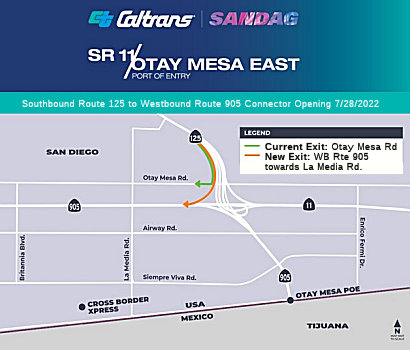 In December 2020, it was reported that San Diego leaders
hosted a remote groundbreaking celebration to mark the start of
construction on the final connector between Route 125 and Route 905, which
will bridge southbound Route 125 to westbound Route 905. This will
complete Route 125 when finished. It will also provide a better connection
between East San Diego County and East Chula Vista to Otay Mesa and the
U.S.-Mexico border.
In December 2020, it was reported that San Diego leaders
hosted a remote groundbreaking celebration to mark the start of
construction on the final connector between Route 125 and Route 905, which
will bridge southbound Route 125 to westbound Route 905. This will
complete Route 125 when finished. It will also provide a better connection
between East San Diego County and East Chula Vista to Otay Mesa and the
U.S.-Mexico border.
(Source: NBC 7 San Diego, 12/17/2020)
In December 2021, it was reported that the new
southbound Route 125 to eastbound Route 905 and eastbound Route 11 freeway
connectors in Otay Mesa were completed. The connectors will provide a
direct highway connection from East County and Chula Vista to the Otay
Mesa area and the existing Otay Mesa Port of Entry. These connectors also
will enhance existing transit connections and create a connection for the
future planned Otay Mesa East Port of Entry.
(Source: District 11 on FB, 12/16/2021)
In July 2022, it was reported that Local and state
officials from the U.S. and Mexico celebrated the completion of Route 11,
which will connect to the future Otay Mesa East Port of Entry.
Representatives from the California Department of Transportation
(Caltrans) and the San Diego Association of Governments (SANDAG) were
joined by area politicians in applauding the project‘s completion.
The new highway will connect East San Diego County to the Otay Mesa area.
Route 11 connects southbound Route 125 to westbound Route 905. The new
connector completes the Route 125/Route 905/Route 11 interchanges that
will improve the border region mobility. The $28.9 million infrastructure
project was made possible by more than $16 million in funding from Senate
Bill (SB) 1, the Road Repair and Accountability Act of 2017.
(Source: NBC San Diego, 7/28/2022)
Siempra Viva Road
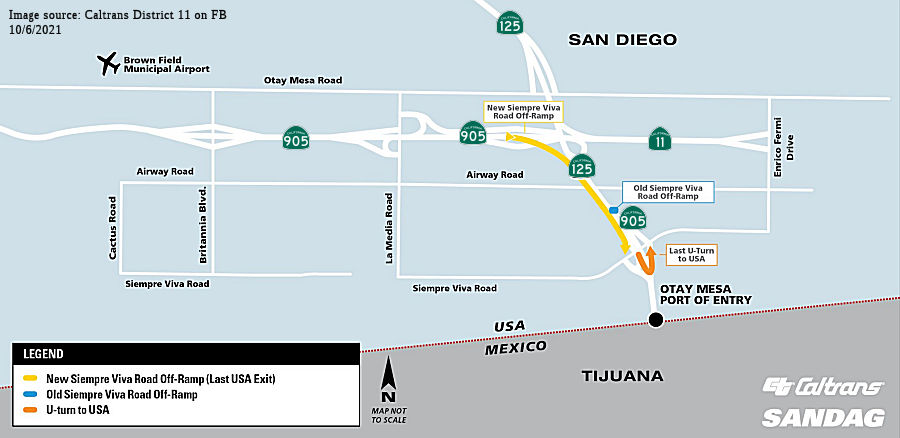 Funding has been considered to build the Siempra Viva Road Interchange (approx SD
R11.374). July 2002 CTC Agenda. According to Don Hagstron in May 2003, the
project is "progressing nicely. Currently, Siempre Viva has been rerouted
to the south of its former location and a new signalized intersection has
been created. To the west of Route 905, a temporary roadway takes you over
to the existing Siempre Viva near the Arco AM/PM station. This new
temporary road actually looks like it might be a piece of the future
ramp."
Funding has been considered to build the Siempra Viva Road Interchange (approx SD
R11.374). July 2002 CTC Agenda. According to Don Hagstron in May 2003, the
project is "progressing nicely. Currently, Siempre Viva has been rerouted
to the south of its former location and a new signalized intersection has
been created. To the west of Route 905, a temporary roadway takes you over
to the existing Siempre Viva near the Arco AM/PM station. This new
temporary road actually looks like it might be a piece of the future
ramp."
The Seimpra Viva Road Interchange opened in December 2004. It is a mile-long segment consisting of an interchange connecting Siempre Viva Road to Route 905. Construction of the freeway will be completed in phases, and it was the first phase of four or more to be completed. Eventually, Route 905 will run west to east, connecting Interstates 5 and 805 to the border crossing. It will run parallel to Otay Mesa Road, 1,300 feet south of it, and lead to a relocated port of entry east of the existing one. Caltrans projects the project will cost $309 million. A total of $216 million in funding has been identified for use on the freeway construction, but there is still a shortfall. Completion is expected in 2008, but planners are eager to finish it as soon as possible.
In October 2021, it was reported that Caltrans and
SANDAG have permanently moved the Siempre Viva Road off-ramp (the last
U.S. exit) to its ultimate configuration. Drivers not intending to go to
Mexico will notice signage directing them to the new exit location. After
this move, travelers who do not wish to cross the border can also use the
U-turn to the USA in the center median. Caltrans relocated the exit
because the prior location was needed for direct connectors where Route 125 is Route 905. It was one of the last remaining improvements to
complete the southbound connector ramps, linking East County and Route 125
to eastbound Route 11, eastbound Route 905, and the existing Otay Mesa
Port of Entry
(Source: District 11 on FB, 10/6/2021; 7 San Diego, 10/8/2021)
In May 2023, the CTC received a request for a 6-month
time extension for the TCEP funds to complete the CON phase for the
multi-funded SB 1 TCEP/Prop 1B TCIF Route 125/Route 905 Connector project,
in San Diego County. The Department has experienced unexpected delays in
completing construction. This project is located at the Route 125/Route 905 separation. The project intends to construct a two-lane local access
ramp connecting Route 905 east of La Media Road, to the intersection at
Enrico Fermi Drive. The project also includes an undercrossing at Sanyo
Avenue, freeway-to-freeway connectors between Route 905 and Route 125, and
a local access ramp to Siempre Viva Road from eastbound Route 905.
Finally, the project intends to construct the remaining southbound
connector from Route 125 to Route 905. The project has a deadline for CCA
of July 31, 2023. The project schedule anticipated 405 working days and
250 days for plant establishment. The project was awarded in July 2020,
but had a 90-day delayed start, which was part of the contract, with
work beginning on November 30, 2022. During construction, the procurement
and development of the water service line for the plant establishment work
was delayed. Coordination with the local water agency took longer
than anticipated and required analyzing various alternatives. This led to
a 6-month delay to the start of the plant establishment work. The
Department anticipates completing the plant establishment by January
2024. Therefore, the Department is requesting a 6-month time extension to
allow sufficient time to complete the project and reach CCA from July 31,
2023 to January 31, 2024.
(Source: May 2023 CTC Agenda, Agenda Item 2.8c.(3))
In October 2021, the CTC approved the following allocation for
preconstruction project phases: $300,000. 11-SD-905 11.737. PPNO 11-1433;
ProjID 1119000045; EA 43064. Route 905 Near San Diego, at the Otay Mesa
Commercial Vehicle Enforcement Facility (CVEF). Add new inspection lane
and truck weighing system. Allocation: PS&E $300,000.
(Source: October 2021 CTC Agenda, Agenda Item
2.5b.(2a) #25)
 Naming
Naming The interchange between I-5 and
Route 905 in the County of San Diego is named the "Caltrans Equipment
Operator II Richard Gonzalez Memorial Interchange" . It was named in
memory of Caltrans Equipment Operator II Richard Gonzalez, a dedicated
maintenance worker. Richard Gonzalez, while working on a special programs
crew at the connector of I-15 and Route 94, was struck on the morning of
June 20, 2011, and died in the line of duty at the age of 52 as a result
of injuries sustained in the collision. Richard Gonzalez was an exemplary
employee who gained the respect of supervisors, management, and peers for
his devotion to the values of integrity, commitment, and teamwork. Richard
Gonzalez's passion was restoration of classic cars and serving as a mentor
and role model to his family and friends. Named by Senate Concurrent
Resolution 52, Resolution Chapter 94, on September 15, 2011.
The interchange between I-5 and
Route 905 in the County of San Diego is named the "Caltrans Equipment
Operator II Richard Gonzalez Memorial Interchange" . It was named in
memory of Caltrans Equipment Operator II Richard Gonzalez, a dedicated
maintenance worker. Richard Gonzalez, while working on a special programs
crew at the connector of I-15 and Route 94, was struck on the morning of
June 20, 2011, and died in the line of duty at the age of 52 as a result
of injuries sustained in the collision. Richard Gonzalez was an exemplary
employee who gained the respect of supervisors, management, and peers for
his devotion to the values of integrity, commitment, and teamwork. Richard
Gonzalez's passion was restoration of classic cars and serving as a mentor
and role model to his family and friends. Named by Senate Concurrent
Resolution 52, Resolution Chapter 94, on September 15, 2011.
(Image Source: Caltrans Website)
 Classified Landcaped Freeway
Classified Landcaped FreewayThe following segments are designated as Classified Landscaped Freeway:
| County | Route | Starting PM | Ending PM |
| San Diego | 905 | 2.84 | 3.56 |
| San Diego | 905 | 4.15 | 5.76 |
 Exit Information
Exit Information Other WWW Links
Other WWW Links Interstate Submissions
Interstate SubmissionsApproved as 139(b) non-chargeable mileage in 1984. This has not yet been constructed to interstate standards, nor is it yet signed as an interstate.
 Freeway
Freeway[SHC 253.8] Entire portion. The portion from Route 5 to Route 125 was added to the Freeway and Expressway system in 1959. The remainder was added to the Freeway and Expressway system in 1991.
 Statistics
StatisticsOverall statistics for Route 905:
© 1996-2020 Daniel P. Faigin.
Maintained by: Daniel P. Faigin
<webmaster@cahighways.org>.